A Top-Down Approach to the Fabrication of Flame-Retardant Wood Aerogel with In Situ-Synthesized Borax and Zinc Borate
Abstract
:1. Introduction
2. Materials and Methods
2.1. Materials
2.2. Preparation of Flame-Retardant Wood Aerogel
- (1)
- Preparation of delignified wood (DW): Balsa wood is sectioned into varying dimensions, such as 15 mm × 15 mm × 15 mm, 10 mm × 100 mm × 5 mm. A 3% sodium chlorite solution is prepared, and its pH is adjusted to 4.5 using glacial acetic acid. Balsa wood specimens are immersed in the sodium chlorite solution and subjected to delignification at 95 °C within an oil bath. Delignification duration ranges from 6 to 24 h. Following the reaction, samples are thoroughly rinsed and subsequently frozen at −40 °C for 12 h. Freeze drying is then conducted using a vacuum freeze dryer for 48 h.
- (2)
- Removal of hemicellulose: Separately, 6%, 8%, and 10% sodium hydroxide solutions are prepared. Zinc oxide particles are added to each solution in varying amounts, maintaining a mass ratio of NaOH to ZnO at 20:1. The mixture is heated and stirred in a water bath until complete dissolution. Subsequently, 4% urea is added to each solution to obtain a homogeneous mixture. Delignified wood obtained from step (1) is immersed in the respective solutions and subjected to a reaction at 90 °C for 5 h. Following the reaction, samples are frozen and subsequently freeze-dried.
- (3)
- Reaction with Boric Acid Solution: A 10% boric acid solution is prepared. Samples treated with the sodium hydroxide–zinc oxide–urea solution are immersed in the boric acid solution and reacted at 80 °C in an oven for 24 h. After the reaction, samples are frozen and subjected to freeze drying, resulting in the preparation of flame-retardant wood aerogels.
2.3. Characterization
3. Results and Discussion
3.1. Morphology and Chemical Structure of the Aerogels
3.2. Mechanical Property Analysis
3.3. Thermal Stability Analysis
3.4. Thermal Insulation Analysis
3.5. Combustion Analysis
3.6. Flame-Retardant Performance Analysis
3.7. Flame-Retardant Mechanism Analysis
4. Conclusions
Supplementary Materials
Author Contributions
Funding
Institutional Review Board Statement
Informed Consent Statement
Data Availability Statement
Conflicts of Interest
References
- Gupta, P.; Singh, B.; Agrawal, A.K. Low Density and High Strength Nanofibrillated Cellulose Aerogel for Thermal Insulation Application. Mater. Des. 2018, 158, 224–236. [Google Scholar] [CrossRef]
- Zhang, L.; Liao, Y.; Wang, Y. Cellulose II Aerogel-Based Triboelectric Nanogenerator. Adv. Funct. Mater. 2020, 30, 2001763. [Google Scholar] [CrossRef] [PubMed]
- Ahankari, S.; Paliwal, P.; Subhedar, A. Recent Developments in Nanocellulose-Based Aerogels in Thermal Applications: A Review. ACS Nano 2021, 15, 3849–3874. [Google Scholar] [CrossRef] [PubMed]
- Kamel, R.; El-Wakil, N.A.; Dufresne, A. Nanocellulose: From an Agricultural Waste to a Valuable Pharmaceutical Ingredient. Int. J. Biol. Macromol. 2020, 163, 1579–1590. [Google Scholar] [CrossRef] [PubMed]
- Xu, T.; Du, H.; Liu, H. Advanced Nanocellulose-Based Composites for Flexible Functional Energy Storage Devices. Adv. Mater. 2021, 33, 2101368. [Google Scholar] [CrossRef] [PubMed]
- Dhali, K.; Ghasemlou, M.; Daver, F. A Review of Nanocellulose as a New Material towards Environmental Sustainability. Sci. Total Environ. 2021, 775, 145871. [Google Scholar] [CrossRef] [PubMed]
- Jiang, F.; Li, T.; Li, Y. Wood-Based Nanotechnologies toward Sustainability. Adv. Mater. 2017, 30, 1703453. [Google Scholar] [CrossRef] [PubMed]
- Lavoine, N.; Bergström, L. Nanocellulose-Based Foams and Aerogels: Processing, Properties, and Applications. J. Mater. Chem. A 2017, 5, 16105–16117. [Google Scholar] [CrossRef]
- Chen, W.; Li, Q.; Wang, Y. Comparative Study of Aerogels Obtained from Differently Prepared Nanocellulose Fibers. ChemSusChem 2014, 7, 154–161. [Google Scholar] [CrossRef]
- Sun, H.; Bi, H.; Lin, X. Lightweight, Anisotropic, Compressible, and Thermally-Insulating Wood Aerogels with Aligned Cellulose Fibers. Polymers 2020, 12, 165. [Google Scholar] [CrossRef]
- Yang, L.; Meng, J.G.; Xue, T. Research of Dissolution Process of Cotton Fiber in LiCl/DMAc Solvent. J. Text. Sci. Eng. 2022, 39, 50–55. [Google Scholar]
- Gao, M.; Cheng, C.Z.; Zhang, D. Dissolution and Spinning Research progress of Cellulose in Alkali/Urea Compound Solvents at Low Temperature. Polym. Bull. 2021, 05, 74–79. [Google Scholar] [CrossRef]
- Berglund, L.A.; Burgert, I. Bioinspired Wood Nanotechnology for Functional Materials. Adv. Mater. 2018, 30, 1704285. [Google Scholar] [CrossRef] [PubMed]
- Niu, F.; Wu, N.; Yu, J. Gelation, Flame Retardancy, and Physical Properties of Phosphorylated Microcrystalline Cellulose Aerogels. Carbohydr. Polym. 2020, 242, 116422. [Google Scholar] [CrossRef] [PubMed]
- He, C.; Huang, J.; Li, S. Mechanically Resistant and Sustainable Cellulose-Based Composite Aerogels with Excellent Flame Retardant, Sound-Absorption, and Superantiwetting Ability for Advanced Engineering Materials. ACS Sustain. Chem. Eng. 2018, 6, 927–936. [Google Scholar] [CrossRef]
- Peng, Q.; Lu, Y.; Li, Z. Biomimetic, Hierarchical-Ordered Cellulose Nanoclaw Hybrid Aerogel with High Strength and Thermal Insulation. Carbohydr. Polym. 2022, 297, 119990. [Google Scholar] [CrossRef]
- Yue, X.; Deng, W.; Zhou, Z. Reinforced and Flame Retarded Cellulose Nanofibril/Sodium Alginate Compound Aerogel Fabricated via Boric Acid/Ca2+ Double Cross-Linking. J. Polym. Environ. 2023, 31, 1038–1050. [Google Scholar] [CrossRef]
- Wang, L.; Sánchez-Soto, M.; Fan, J. Boron/Nitrogen Flame Retardant Additives Cross-linked Cellulose Nanofibril/Montmorillonite Aerogels toward Super-low Flammability and Improved Mechanical Properties. Polym. Adv. Technol. 2019, 30, 1807–1817. [Google Scholar] [CrossRef]
- Liu, Q.; Chai, Y.; Ni, L. Flame Retardant Properties and Thermal Decomposition Kinetics of Wood Treated with Boric Acid Modified Silica Sol. Materials 2020, 13, 4478. [Google Scholar] [CrossRef]
- Di Blasi, C.; Branca, C.; Galgano, A. Flame Retarding of Wood by Impregnation with Boric Acid—Pyrolysis Products and Char Oxidation Rates. Polym. Degrad. Stab. 2007, 92, 752–764. [Google Scholar] [CrossRef]
- Salman, S.; Pétrissans, A.; Thévenon, M.F. Development of New Wood Treatments Combining Boron Impregnation and Thermo Modification: Effect of Additives on Boron Leachability. Eur. J. Wood Prod. 2014, 72, 355–365. [Google Scholar] [CrossRef]
- Wang, Q.L.; Wang, Q.L. Chemical Mechanism of Fire Retardance of Boric Acid on Wood. Wood Sci. Technol. 2004, 38, 375–389. [Google Scholar] [CrossRef]
- Hou, X.; Li, Z.; Zhang, Z. Selectively Producing Acetic Acid via Boric Acid-Catalyzed Fast Pyrolysis of Woody Biomass. Catalysts 2021, 11, 494. [Google Scholar] [CrossRef]
- Zhang, J.; Koubaa, A.; Xing, D. Conversion of Lignocellulose into Biochar and Furfural through Boron Complexation and Esterification Reactions. Bioresour. Technol. 2020, 312, 123586. [Google Scholar] [CrossRef] [PubMed]
- Nabipour, H.; Nie, S.; Wang, X. Highly Flame Retardant Zeolitic Imidazole Framework-8@cellulose Composite Aerogels as Absorption Materials for Organic Pollutants. Cellulose 2020, 27, 2237–2251. [Google Scholar] [CrossRef]
- Fan, B.; Chen, S.; Yao, Q. Fabrication of Cellulose Nanofiber/AlOOH Aerogel for Flame Retardant and Thermal Insulation. Materials 2017, 10, 311. [Google Scholar] [CrossRef] [PubMed]
- Ren, X.; Song, M.; Jiang, J. Fire-Retardant and Thermal-Insulating Cellulose Nanofibril Aerogel Modified by In Situ Supramolecular Assembly of Melamine and Phytic Acid. Adv. Eng. Mater. 2022, 24, 2101534. [Google Scholar] [CrossRef]
- ASTM E2550; Standard Test Method for Thermal Stabilityby Thermogravimetry. ASTM International: West Conshohocken, PA, USA, 2017.
- ASTM D2863-2009; Standard Test Method for Measuring the Minimum Oxygen Concentration to Support Candle-like Combustion of Plastics (Oxygen Index). ASTM International: West Conshohocken, PA, USA, 2009.
- ASTM D3801-20a; Standard Test Method for Measuring the Comparative Burning Characteristics of Solid Plastics in a Vertical Position. ASTM International: West Conshohocken, PA, USA, 2020.
- ASTM D7309-2007; Standard Test Method for Determining Flammability Characteristics of Plastics and Other Solid Materials Using Microscale Combustion Calorimetry. ASTM International: West Conshohocken, PA, USA, 2007.
- GB/T 2677.8-1994; Fibrous Raw Material. Determination of Acid-Insoluble Lignin. The State Bureau of Quality and Technical Supervision: Beijing, China, 1994.
- Zhu, G.; Zhang, C.; Li, K. A Multifunctional Zeolitic Imidazolate Framework-8@wood Aerogel Composite Intergrating Superior Performance of Dye Adsorption Capacity and Flame-Retardant Property. J. Porous Mater. 2023, 30, 1171–1182. [Google Scholar] [CrossRef]
- Qin, Q.; Guo, R.; Ren, E. Waste Cotton Fabric/Zinc Borate Composite Aerogel with Excellent Flame Retardancy. ACS Sustain. Chem. Eng. 2020, 8, 10335–10344. [Google Scholar] [CrossRef]
- Zhu, Z.; Fu, S.; Lucia, L. A Fiber-Aligned Thermal-Managed Wood-Based Superhydrophobic Aerogel for Efficient Oil Recovery. ACS Sustain. Chem. Eng. 2019, 7, 16428–16439. [Google Scholar] [CrossRef]
- Tanpichai, S.; Phoothong, F.; Boonmahitthisud, A. Superabsorbent Cellulose-Based Hydrogels Cross-Liked with Borax. Sci. Rep. 2022, 12, 8920. [Google Scholar] [CrossRef] [PubMed]
- Younis, A.A. Optimization of Mechanical, Thermal, and Ignition Properties of Polyester Fabric Using Urea and Phosphoric Acid. J. Ind. Text. 2020, 49, 791–808. [Google Scholar] [CrossRef]
- Cheng, X.; Zhu, S.; Pan, Y. Fire Retardancy and Thermal Behaviors of Cellulose Nanofiber/Zinc Borate Aerogel. Cellulose 2020, 27, 7463–7474. [Google Scholar] [CrossRef]
- Hao, D.; Wang, R.; Wang, W.Q. Application and Progress of Boron-Based Flame Retardants in Flame Retardant Polymers. Polym. Mater. Sci. Eng. 2021, 37, 115–123. [Google Scholar] [CrossRef]
- Bai, X.Y.; Che, D.Y.; Jiang, W.Q. TG-FTIR analysis of cellulose pyrolysis. Renew. Energy Resour. 2015, 33, 1582–1588. [Google Scholar] [CrossRef]
- Luo, X.; Li, Z.; Shen, J.; Liu, L.; Chen, H.; Hu, Z.; Krucinska, I.; Yao, J. A Facile Strategy to Achieve Efficient Flame-Retardant Cotton Fabric with Durable and Restorable Fire Resistance. Chem. Eng. J. 2022, 430, 132854. [Google Scholar] [CrossRef]
- Wang, J.; Du, C.W.; Shen, Y.Z. Measurement of Ammonia in Soil Headspace by Mid-infrared Photoacoustic Spectroscopy. Soils 2014, 46, 1017–1023. [Google Scholar] [CrossRef]
- Wang, Z.; E, Y.; Li, J.; Du, T.; Wang, K.; Yao, X.; Jiang, J.; Wang, M.; Yuan, S. Sustainable Bacterial Cellulose-Based Composite Aerogels with Excellent Flame Retardant and Heat Insulation. Cellulose 2023, 30, 9563–9574. [Google Scholar] [CrossRef]

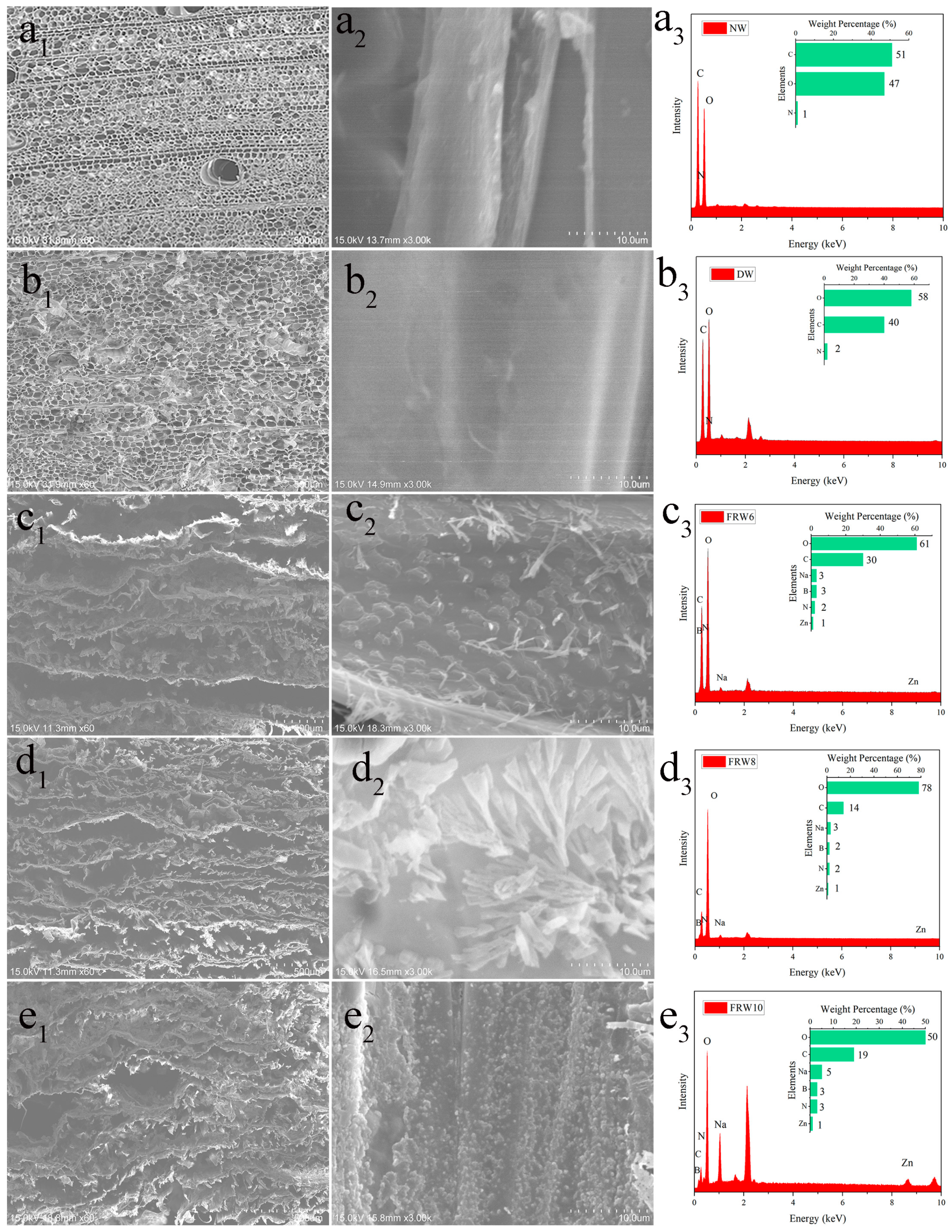
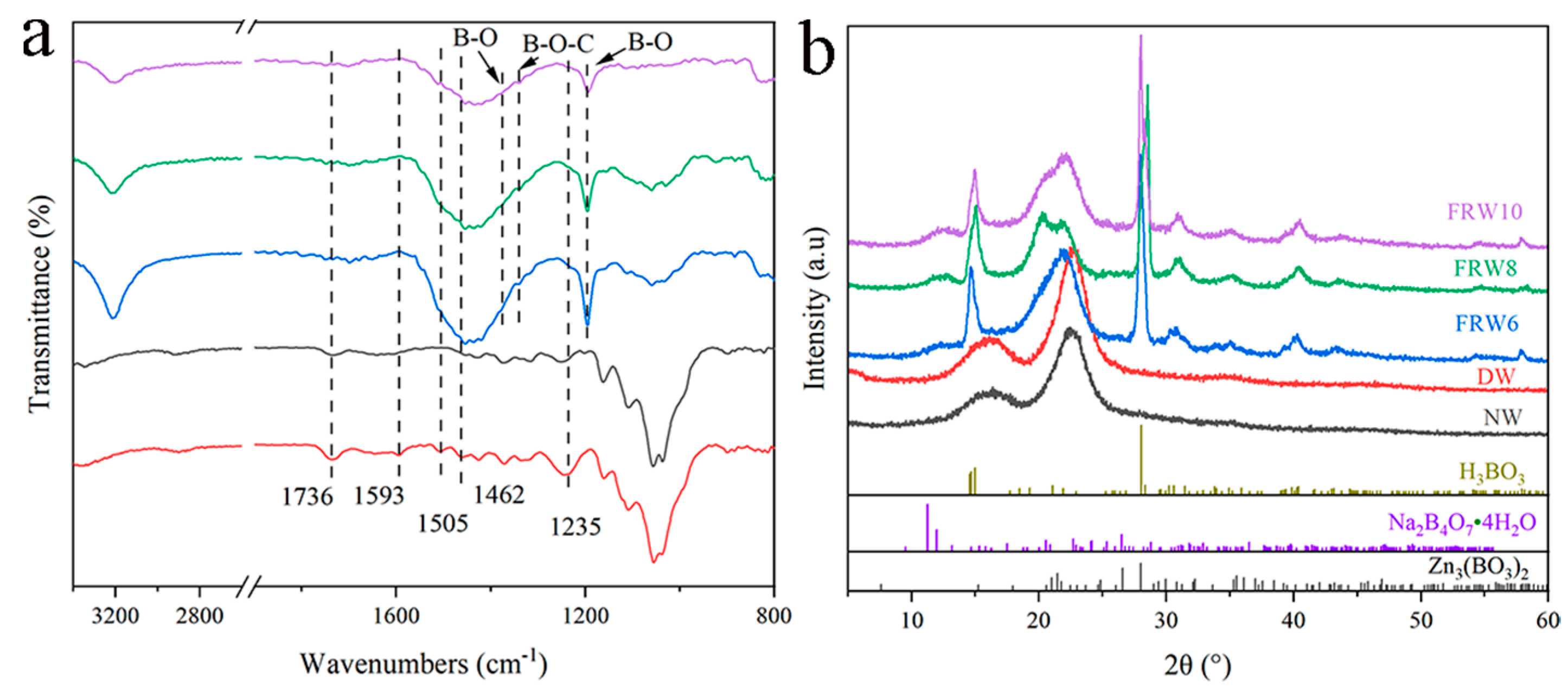
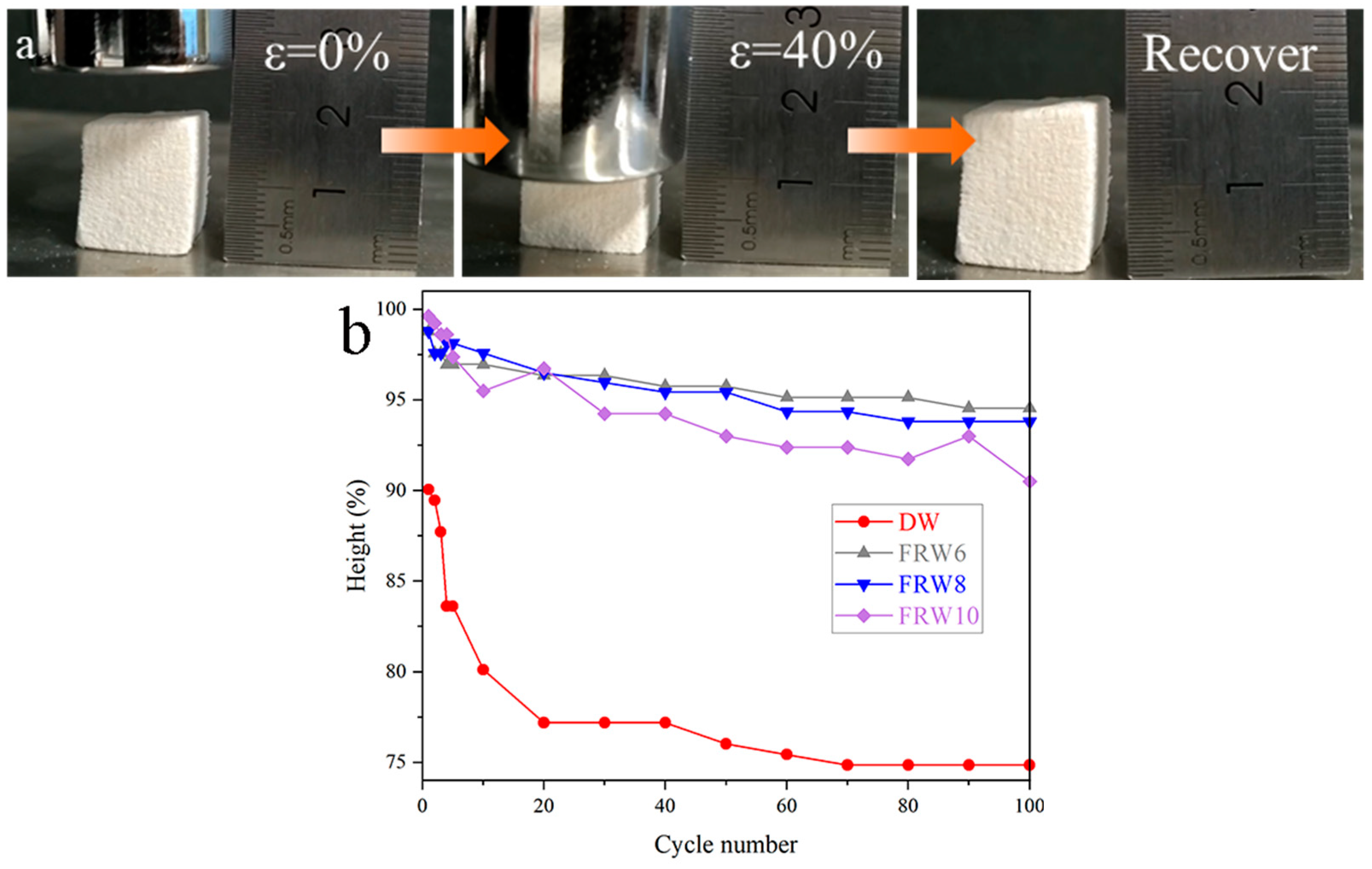

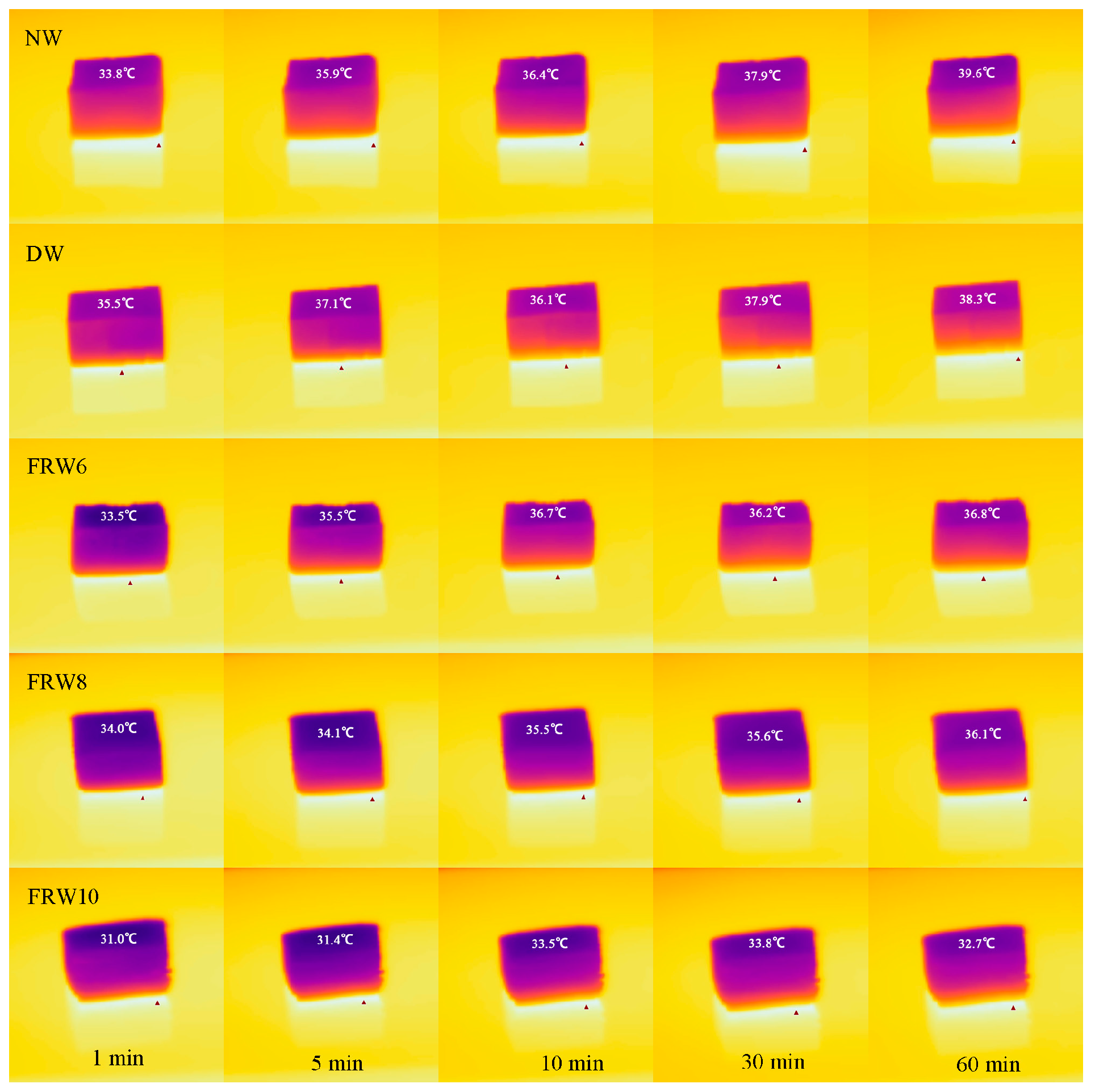

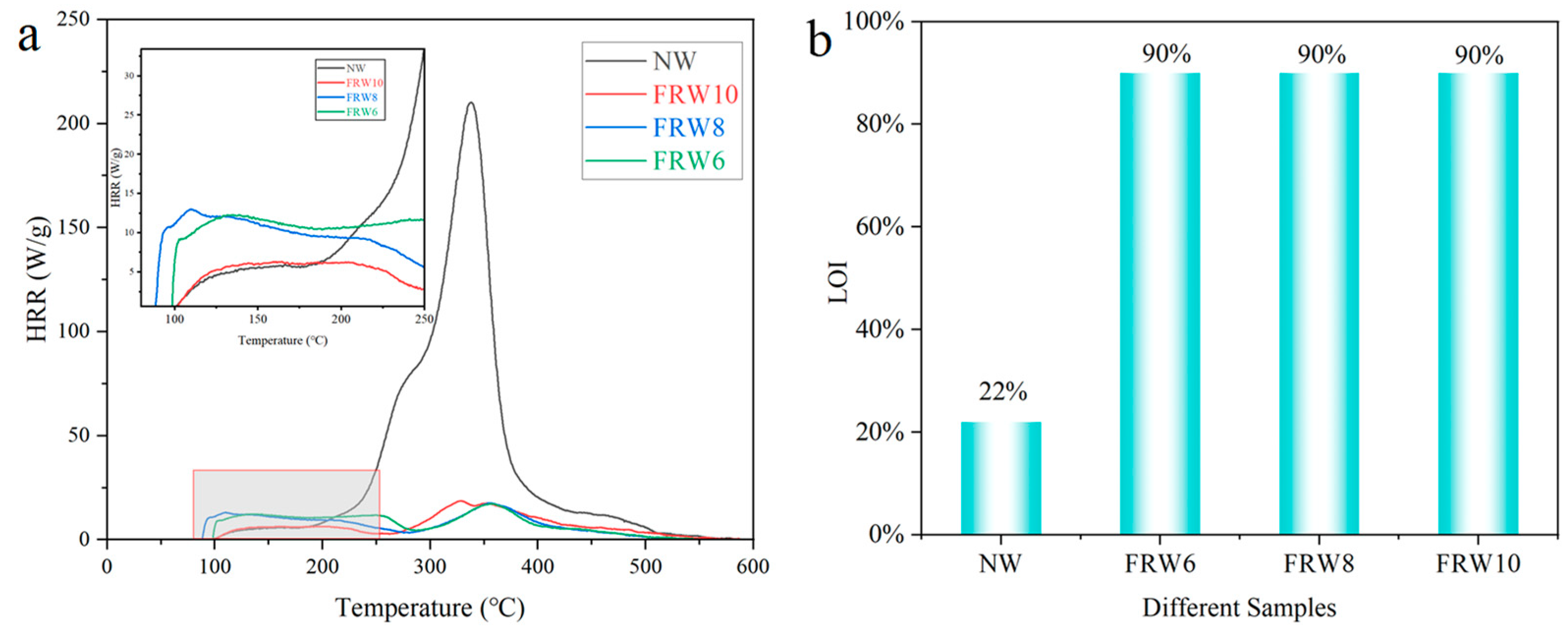
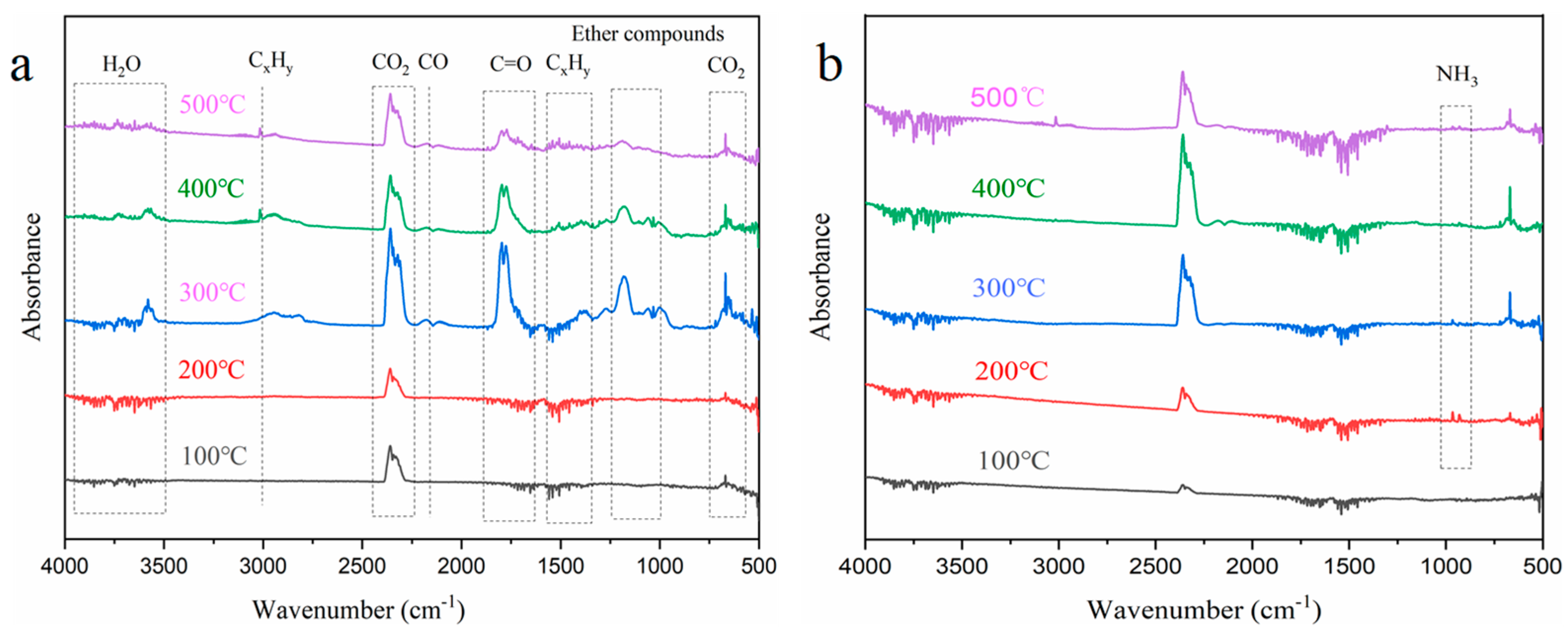
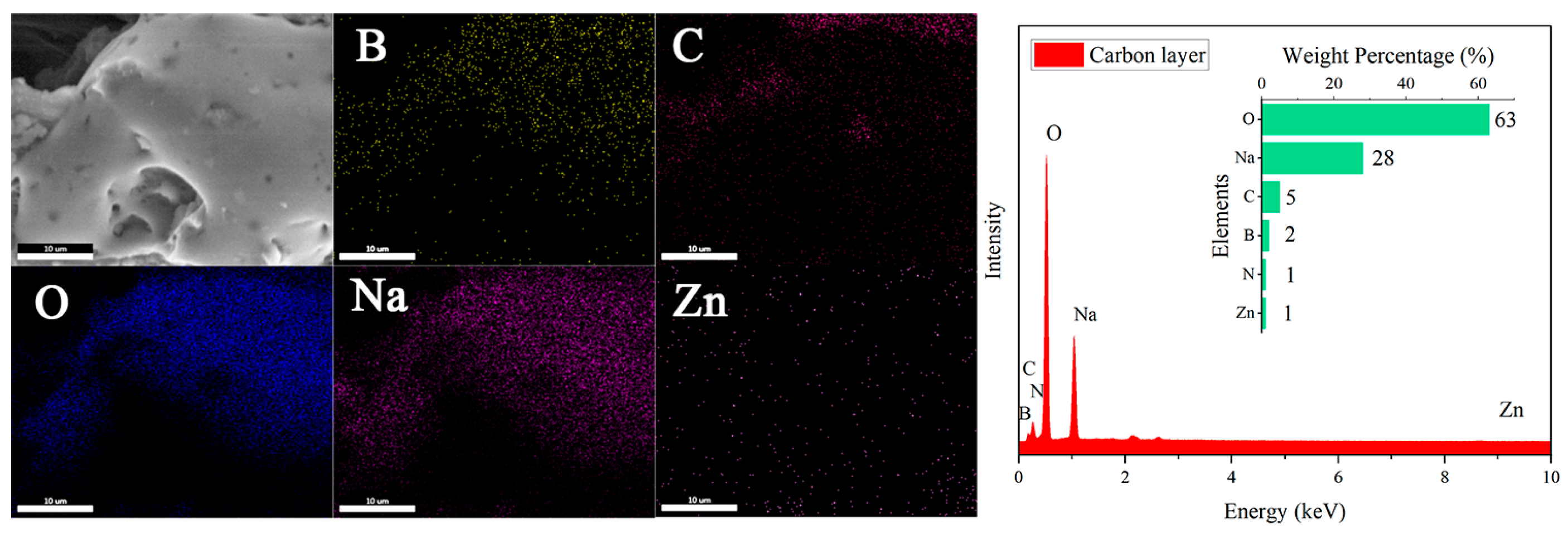

| Sample | NW | DW | FRW6 | FRW8 | FRW10 |
|---|---|---|---|---|---|
| Density (g/cm3) | 0.151 | 0.100 | 0.113 | 0.122 | 0.124 |
| Sample | NW | DW | FRW6 | FRW8 | FRW10 |
|---|---|---|---|---|---|
| Residue (%) | 11.02 | 15.22 | 47.69 | 49.27 | 56.16 |
| T10% (°C) | 285.91 | 285.11 | 123.11 | 128.49 | 125.11 |
| Tmax1 (°C) | - | - | 132.79 | 131.92 | 132.18 |
| Vmax1 (%/°C) | - | - | −0.56 | −0.45 | −0.45 |
| Tmax2 (°C) | 356.04 | 349.76 | 341.43 | 341.69 | 341.98 |
| Vmax2 (%/°C) | −1.28 | −1.76 | −0.17 | −0.18 | −0.11 |
| Sample | NW | FRW6 | FRW8 | FRW10 |
|---|---|---|---|---|
| THR (KJ/g) | 18.7 | 3.8 | 3.6 | 3.4 |
| PHRR (W/g) | 210.2 | 17.3 | 17.5 | 18.4 |
| Tmax (°C) | 338.2 | 356.1 | 354.4 | 328 |
| Sample | NW | FRW6 | FRW8 | FRW10 |
|---|---|---|---|---|
| T1 (s) | 35.0 | 0.9 | 0.9 | 0.8 |
| T2 (s) | - | 0.8 | 0.7 | 0.7 |
| T3 (s) | - | 0.1 | 0.1 | 0.1 |
| Tf(T1 + T2) (s) | 178.0 | 8.7 | 8.6 | 7.9 |
| (T2 + T3) (s) | - | 0.9 | 0.9 | 0.9 |
| Whether residual flame or burn spreads to the fixture | YES | NO | NO | NO |
| Whether burning particles or droplets ignite cotton pads | NO | NO | NO | NO |
| UL-94 | - | V-0 | V-0 | V-0 |
Disclaimer/Publisher’s Note: The statements, opinions and data contained in all publications are solely those of the individual author(s) and contributor(s) and not of MDPI and/or the editor(s). MDPI and/or the editor(s) disclaim responsibility for any injury to people or property resulting from any ideas, methods, instructions or products referred to in the content. |
© 2024 by the authors. Licensee MDPI, Basel, Switzerland. This article is an open access article distributed under the terms and conditions of the Creative Commons Attribution (CC BY) license (https://creativecommons.org/licenses/by/4.0/).
Share and Cite
Lin, M.; Guo, X.; Xu, Y.; Zhang, X.; Hu, D. A Top-Down Approach to the Fabrication of Flame-Retardant Wood Aerogel with In Situ-Synthesized Borax and Zinc Borate. Materials 2024, 17, 2638. https://doi.org/10.3390/ma17112638
Lin M, Guo X, Xu Y, Zhang X, Hu D. A Top-Down Approach to the Fabrication of Flame-Retardant Wood Aerogel with In Situ-Synthesized Borax and Zinc Borate. Materials. 2024; 17(11):2638. https://doi.org/10.3390/ma17112638
Chicago/Turabian StyleLin, Mingzeng, Xiangkun Guo, Yinchao Xu, Xuejin Zhang, and Donghao Hu. 2024. "A Top-Down Approach to the Fabrication of Flame-Retardant Wood Aerogel with In Situ-Synthesized Borax and Zinc Borate" Materials 17, no. 11: 2638. https://doi.org/10.3390/ma17112638




